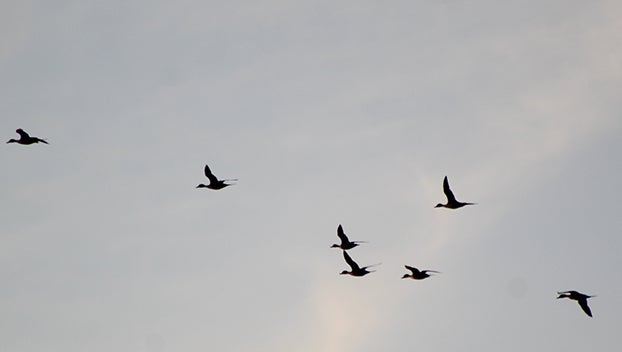Pintails make rebound in 2023 Waterfowl Survey Report
Published 3:00 pm Wednesday, August 23, 2023

- A flock of pintail ducks fly over The Swamp area of St. Catherine Creek National Wildlife Refuge at the Sibley Unit. (Hunter Cloud | The Natchez Democrat)
|
Getting your Trinity Audio player ready...
|
NATCHEZ — The United States Fish and Wildlife Service published the 2023 Waterfowl Population survey Friday. The survey contains data about the estimated number of breeding waterfowl and available habitat and is used to set hunting regulations.
Pond counts are a key indicator of crucial duck habitat and potential breeding capabilities in the prairie pothole region. The majority of ducks hunted in the Mississippi Flyway are bred in North and South Dakota, Manitoba and Saskatchewan Provinces. The USFWS survey in May indicated there were 4.98 million ponds, a nine percent decrease from last year and 5 percent below the long-term average.
Louisiana duck hunters financially support Delta Waterfowl with the purchase of duck stamps to help improve habitat in the prairie. Delta Waterfowl reported there was a timely rain in the region after the pond survey was conducted, so it should help boost duck numbers. Dave Scott, Mississippi Flyways Representative for the United States Fish and Wildlife Service, said the habitat conditions are a matter for waterfowl populations
“Ongoing drought conditions in the Canadian prairies are worth noting for future years in this area. Its habitat is crucial for many of the breeding waterfowl that make up the Mississippi Flyway’s fall flight,” Scott said. “ Improved water and habitat conditions in a portion of the US prairies (eastern Montana and the Dakotas) was important for this year’s production. The fall flight and hunter opportunities will partly be driven by production coming from this region.”
The survey reports an overall population of 32.32 million ducks, down seven percent from 2022 and nine percent from the long-term average. It is important to remember these ducks represent the breeding pool and not the number of birds that will fly south this fall.
Scott said anecdotal reports he has heard show the production in some parts of the prairie has been good. USFWS does not conduct a brood survey at this time. He added hunters can remain optimistic for a good fall hunting season.
Highly Pathogenic Avian Influenza positive cases have slowed down since last year.
“HPAI is still an issue, but it seems to have been less of a widespread issue for waterfowl and other birds this summer compared to 2022,” Scott said. “We have no direct evidence that HPAI has significantly impacted our waterfowl populations or the expected fall flight.”
Numbering the birds
Mallards have a population of 6.13 million, 23 percent below the long-term average. Gadwall has a population of 2.56 million, 25 percent higher than the long-term average but five percent below 2022. American Wigeon had a population of 1.89 million, 28 percent below the long-term average.
The survey reports 2.5 million green-winged teal, 16 percent higher than 2022 and 15 percent higher than the long-term average. The pintail population improved in 2023. The survey reports northern pintail totaled 2.2 million, a 24 percent increase from 2022. There is still work to do for pintail as the population is still 43 percent down from the long-term average.
Shovelers came in at 2.86 million birds, eighth percent higher than the long-term average. Redheads had a population of 930,000, 27 percent higher than the long-term average. Canvasbacks had a population of 620,000, six percent above the population in 2022 and five percent higher than the long-term average.
“In summary, the positive survey results and increases for pintails and green-winged teal are great news and hopefully decent to above average production will offset the lower mallard numbers estimated from the spring surveys,” Scott said.
Helping conservation
Louisiana helps fund conservation in the breeding grounds by allocating state duck stamp funds to groups like Delta Waterfowl. Mississippi does the same thing, allocating state duck stamp funds to improve habitat up north while funding projects in the Mississippi delta to provide crucial habitat for wintering waterfowl.
MDWFP Waterfowl Program Coordinator Houston Havens usually gives an update on those projects and the funding in the September or October commission meeting. Hunters in Louisiana and Mississippi can continue to help the conservation of ducks in several different ways.
“Waterfowl hunters can be mentors and take youths and others with an interest out hunting for the first time and share their knowledge of and passion for the great outdoors and wildlife conservation with the next generation,” Scott said. “Working locally and with national conservation organizations that protect and restore wildlife habitat is a great way to give back and ensure the future of the endeavors they enjoy each fall.”
To read the full population survey report visit USFWS.com.





